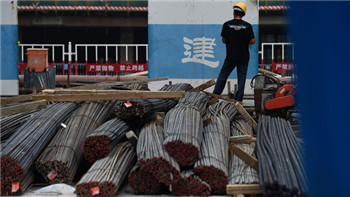
China’s banks granted new loans at the fastest pace on record in January, a sign that Beijing is loosening monetary policy more aggressively in an attempt to bolster the slowing economy.
今年1月,中国各银行新增贷款速度达到有记录以来最快,这一迹象表明,中国正在更加积极地放松货币政策,以提振日益放缓的经济。
China grew at its slowest pace since 1990 last year, dragged down by a severe downturn in manufacturing and construction, once the main growth drivers.
去年,中国经济增速达到自1990年以来最慢,曾经是主要增长推动力的制造业和建筑业严重低迷,拖累了经济增长。
Policymakers have sought to strike a balance between supporting short-term growth with interest-rate cuts and higher loan volumes without exacerbating longer-term risks from excessive debt. Loan demand from corporate borrowers has also been tepid, as factory owners delay investments amid severe overcapacity in many sectors.
迄今为止,政策制定者希望实现这种平衡:通过降息和增加贷款规模支持短期增长,同时不加剧过度负债带来的较长期风险。同时企业借款人对贷款的需求也显得乏力,在很多行业产能严重过剩之际,工厂所有者纷纷推迟了投资。
That trend appeared to reverse in January, however, as new local currency bank loans to the real economy soared to a monthly record of Rmb2.5tn ($390bn). Credit from all sources, including bonds and off-balance-sheet lending, was Rmb3.2tn, also a monthly record, as corporate bond issuance hit an all-time high.
然而,这种趋势似乎在1月逆转,进入实体经济的新增人民币贷款飙升至2.5万亿元人民币(合3900亿美元)的月度新高。社会融资规模增量为3.42万亿元人民币,也创下了月度纪录,其中企业债券发行量达到有史以来最高。
“Judging from recent speeches by top leaders and January’s credit growth, this year policymakers seem to be determined to make the economy grow above their bottom line of 6.5 per cent,” said Larry Hu, China economist at Macquarie Securities.
麦格理证券(Macquarie Securities)中国经济学家胡伟俊(Larry Hu)表示:“根据最高领导人最近的演讲和1月份信贷增速判断,今年政策制定者似乎决心让经济增速高于6.5%的底线。”
Residential mortgages helped drive January’s strong lending figure, the latest sign that China’s housing market is gradually recovering from a downturn that began in 2014. However, UBS economist Donna Kwok cautioned that banks are “unlikely” to maintain last month’s record pace, especially while the central bank continues to encourage “prudent credit expansion”.
住房抵押贷款帮助推动了今年1月的强劲放贷数据,这一最新迹象表明,中国楼市正从2014年开始的低迷逐渐回暖。然而,瑞银(UBS)经济学家郭浩庄(Donna Kwok)告诫称,银行“不太可能”保持上月的创纪录贷款增速,特别是在央行继续鼓励“审慎信贷扩张”之际。
January is nearly always the biggest month of the year for lending, as banks have fresh loan quotas to start the calendar year. The timing of this year’s lunar new year holiday is likely to have amplified this seasonality, as banks accelerated lending ahead of the break.
1月几乎总是一年中放贷规模最高的月份,因为银行在每个日历年的开始拥有新的贷款额度。今年春节假期所处的时间可能放大了这种季节效应,因为银行会在春节假期之前加快放贷。
Renminbi depreciation may also have boosted demand for loans. In the years when the renminbi was viewed as a one-way bet to appreciate, Chinese companies were eager to borrow in dollars, since the debt burden was expected to be lighter in renminbi terms when the loan came due. Now, the opposite dynamic is at play, and many Chinese companies are borrowing in renminbi to replace foreign currency debt.
人民币贬值可能也推动了贷款需求。在人民币汇率被认为只升不降的几年里,中国企业希望借入美元,因为他们预期,在贷款到期时,以人民币计算的贷款负担会减轻。如今的情况相反,很多中国企业正借入人民币,取代外币贷款。












